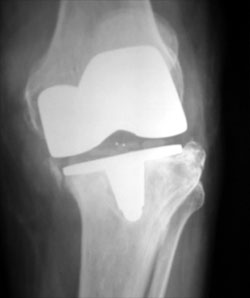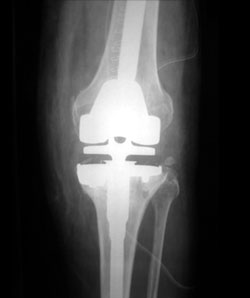Revision joint replacement surgery
As the name suggests, revision joint replacement refers to the surgical procedure that is conducted to replace a damaged joint replacement. In simple terms when a person undergoes a joint replacement surgery and due to some reason the replaced prosthetics also get spoiled then another revision joint replacement surgery is done so that the ability of the joint to move can be restored.
This surgical procedure is also known as revision arthroplasty. The procedure of revision joint replacement is more complex as compared to the joint replacement surgery, which was performed initially on the patient. Along with the complications, this surgery has relatively less conventional results. Every time the original joint replacement surgery fails, the revision surgery becomes more and more difficult. A revision surgery can be performed as many times as required but with increasing complexities.
Failed Primary Arthroplasty

Post Revision Joint Replacement

Causes –
Reasons for a revision joint replacement surgery –
Dilapidated prosthetics –
Post joint replacement surgery, the prosthetics, which were used to replace the actual damaged bones, tend to worn out with passing time. Since they are made of different materials, these prosthetics are in good condition for a certain durability span and after that they start malfunctioning. This malfunctioning causes issues and thus after examination by the surgeon it needs to be extracted and replaced by a new prosthetic on its place.
Infection –
This is the most common occurrence after a joint replacement surgery. It usually occurs due to the introduction of an artificial prosthetic in place of the actual joint. However if this infection is detected right after the surgery or over a few weeks after the replacement then it can be treated with a separate operation to cure the surgery. However, if this infection is detected after a long time span of six weeks, it takes a severe form and then it might not be possible to cure it through a normal surgery. In such a case, the surgeon goes through the current condition of the infection and accordingly decides whether the patient requires a replacement surgery.
Dislocation and instability –
In any kind of joint replacement, dislocation and instability is highly suspected. With frequent motion, the prosthetic might shift from its original place or might not hold on to its assigned and desired place after a certain time post the replacement surgery. This might occur due to excessive stress, vigorous motion or low quality implants. The revision joint replacement surgery aims at fixing this issue by using a better prosthetic in a more specialized manner. After the issue detected in the initial replacement, it becomes easy for the surgeon to rectify the features, which were lacking in the older prosthetic and use a better option for the revision replacement.
Wrong positioning of a joint –
This is a rare situation, which happens in case of complex joint replacements. In this case, the prosthetic is placed in a wrong position initially and remains there even after the surgery. This causes numerous issues like stiffness in the joint, limited motion of the joint and might even lead to rapid wearing of the prosthetic. In such a case, revision joint replacement is very essential to place the prosthetics back into the right position for easy and convenient movement of the joint.
Post replacement pain –
A joint replacement surgery is done to cure the pain and ensure proper movement of the joint by replacing the damaged joint with a prosthetic. Ideally, after the surgery, the joint must function efficiently as it was functioning when the natural joint was free from issues. However, in case if the pain and complications occur even after the surgery, then it is important for the patient to get in touch with their surgeon and consult them about the problem. There can be a numerous reasons subjective to every individual suffering from pain after the replacement surgery but in some cases it can be chronic and the surgeon might suggest for a revision joint replacement surgery.
Procedure –
A revision joint replacement surgery tends to be more complicated than the initial joint replacement surgery. It is preferable to be carried out by the same surgeon as they are already well versed with your medical background and the history of your surgery. This revision replacement surgery is done in a hospital or a certified clinic by an expert specialized surgeon.
Here are some of the basic steps that are carried out during the revision replacement surgery –
- The very first step is consulting a specialist who would examine the condition of your joints and prosthetics of the affected area.
- The doctor will conduct physical tests to check the movement and problems of the muscle by testing the pain durability, swelling and other factors.
- After the physical test, blood tests will be conducted to check the condition of the blood cells near the affected area. Tests will also be conducted to check the status of tissues and muscles surrounding the affected area.
- An X-ray will be conducted and previous medical records will be checked to study the previous and current condition of the affected joint and the patient’s health.
- After all these tests and examinations, the surgeon will decide whether the patient is in need of a revision replacement surgery or not. In case if the patient requires a revision replacement surgery, they are informed about the procedure and other essential information about it.
- Before the surgery, the area about to be operated is treated with anesthesia and the surgery is carried out.
- In some cases the same prosthetic is put in proper place while in some cases the prosthetic is replaced.
- After the surgery, the patient is given medications, few exercises and information about the precautions, which are supposed to be taken care of.
Complications –
Revision joint replacement surgeries are more complex than normal joint replacement surgeries. This complexity is due to the formation of scar tissues, loss of the natural bone and the intricacies in handling the stiff prosthetics. During the consultation, your surgeon will inform you about the risks, which might accompany your revision joint replacement surgery. Some of these risks might be ordinary while some might be subjective, depending upon the patient’s health check and other critical pointers associated to their health. With every revision replacement surgery, the risk and complexities keep on increasing however, with proper care and expert guidance the risks which prevail during this surgery can be avoided.
Frequently asked questions
In case if you are facing any kind of issue in the movement of your joint or if it is causing pain or not allowing proper movement like your original joints, you must consult a surgeon and they will further examine you and inform you if you need a revision replacement surgery.
The pain involved in this surgery is nearly the same as the total joint replacement surgery but it might also be subjective to the level of pain endurance in an individual.
The basic aim of a revision surgery is to resolve the complications, which prevailed even after the initial joint replacement surgery. However, one cannot be sure whether they will be in need of a second or a third revision joint replacement surgery. It totally depends upon the individual and the durability of their prosthetics.
